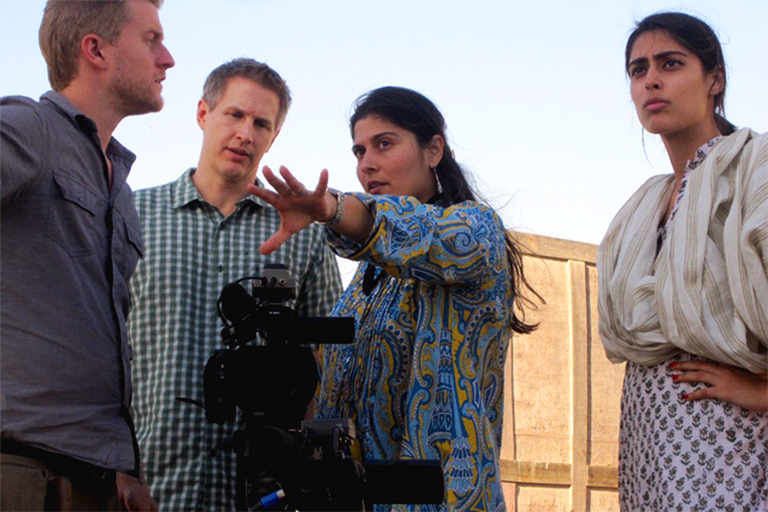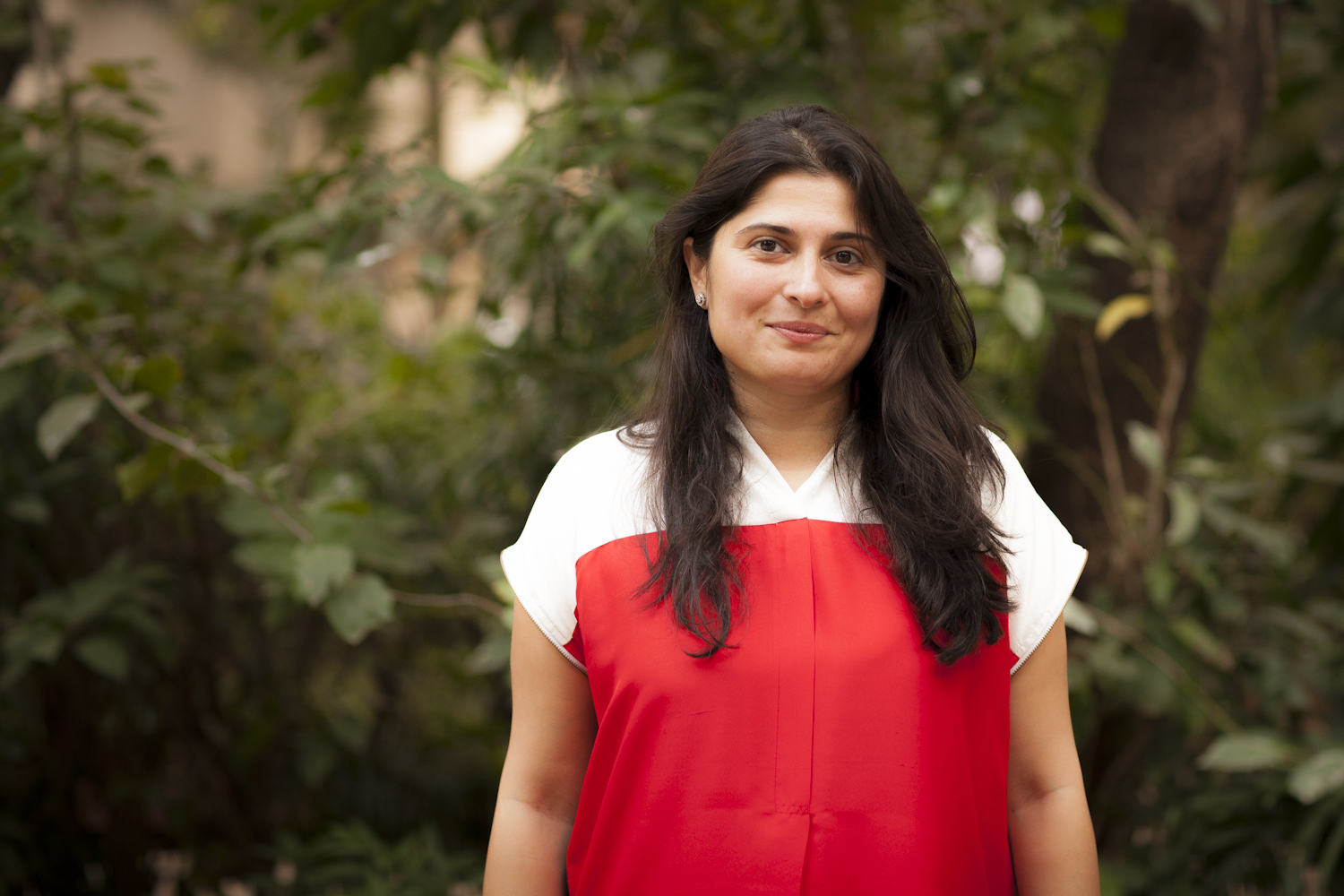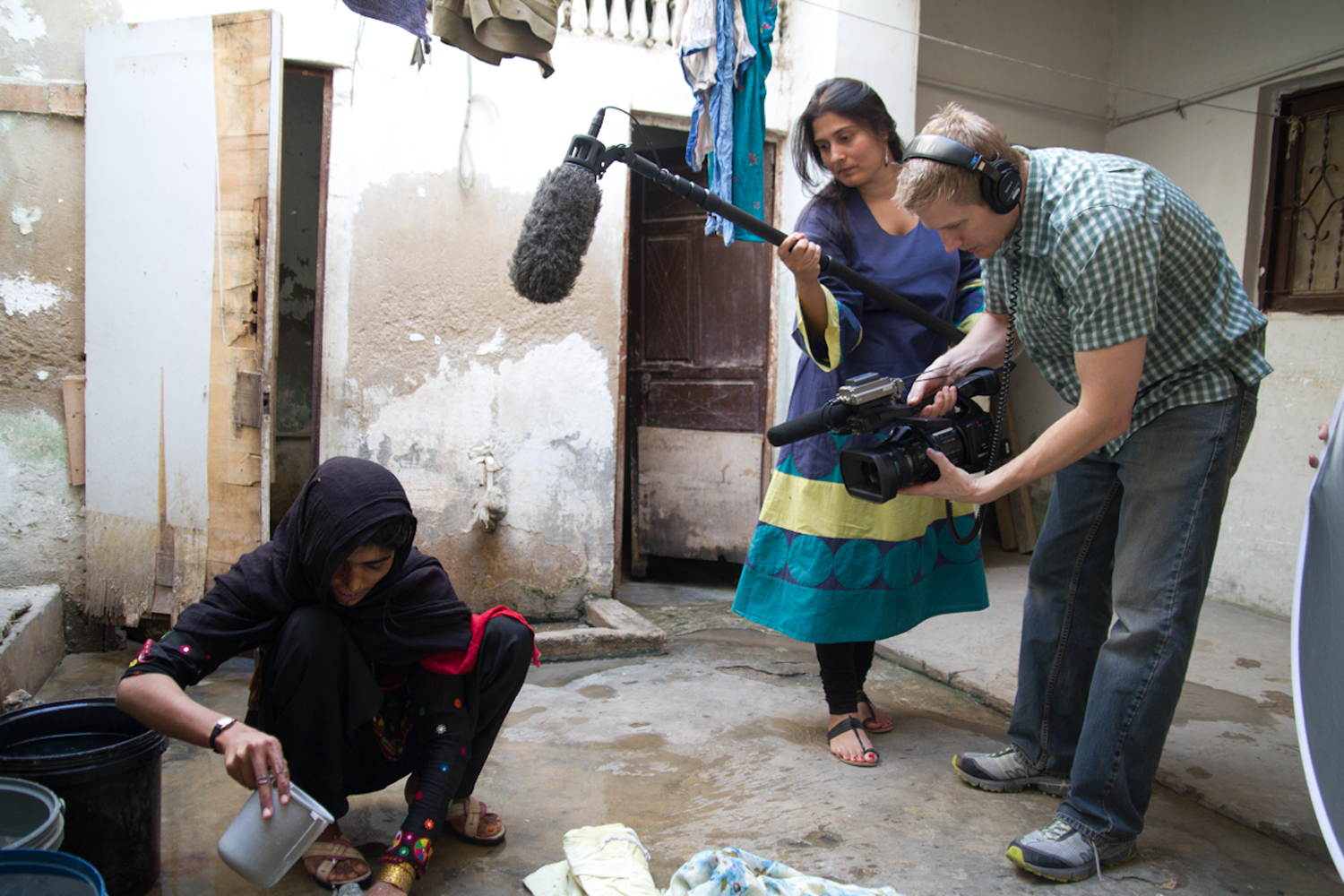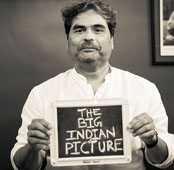-
 Sharmeen Obaid Chinoy | Kavi Bhansali for TBIP
Sharmeen Obaid Chinoy | Kavi Bhansali for TBIP -
 Poster of Saving Face
Poster of Saving Face -
 Sharmeen Obaid Chinoy holds the boom mike while directing/interviewing (Behind the scenes, Saving Face)
Sharmeen Obaid Chinoy holds the boom mike while directing/interviewing (Behind the scenes, Saving Face) -
 Still from Saving Face
Still from Saving Face -
 Sharmeen Obaid Chinoy discusses a shot with her crew (Behind the scenes, Saving Face)
Sharmeen Obaid Chinoy discusses a shot with her crew (Behind the scenes, Saving Face)
Sharmeen Obaid Chinoy, 34, is a documentary filmmaker who was born and raised in Karachi and now lives between Canada and Pakistan. She has been in the news for having won the Oscar for her film Saving Face— a documentary on women who have been victims of acid attacks in Pakistan. She is also the recipient of a number of other highly coveted awards, including the Emmy (for Pakistan’s Taliban Generation in 2010) and was included in the Time Magazine’s annual list of the 100 most influential people in the world last year. But Sharmeen’s body of work transcends the glory of recognition. She has made over a dozen films in 10 countries focussed on human rights and women’s issues— consistently trying to give voice to marginalized people. After Saving Face she has gone on to make a film on Transgenders in Pakistan and a television series, Ho Yaqeen, that features ordinary citizens who fight for justice and change in her country. She is currently working on a film called Sounds Of Sachal, on an orchestra from Lahore that is reviving and reinventing traditional Pakistani music.
What attracted you to journalism in the beginning?
I always knew I would work in the field of journalism. While I did not have an inclination towards film back then, I have been writing for various news sources since I was fourteen.
Did you study film-making? Where and what?
I have never studied film-making.
The Academy Award might be the biggest milestone in your career so far, but personally what do you consider your biggest achievement?
When I look at my daughter, Amelia, I feel that she is my biggest achievement. Despite all the fulfillment that my work brings me, nothing can rival the joy spending time with my husband and daughter brings me.
Your efforts to showcase what is wrong with your society are foremost a voice against cynicism— the ‘what will change’ question. While complete change might take very long to come, what are some of the smaller consequences you wish would come of your cinema? What might be some of the (however small) changes that your films have managed to bring about anywhere?
Through film my aim is to raise awareness about hidden issues, and to provoke people into questioning their preconceived notions and rethink the way they see a community or phenomenon. For example my film, Transgenders: Pakistan’s Open Secret, sheds light onto the customs and traditions of the transgender community in Pakistan from a humanist perspective. I hope that it will force Pakistanis to reconsider their current disposition towards them.
Saving Face has already stimulated worldwide attention on the topic of acid violence. Attacks are now being reported at a higher rate in Pakistan, and a lot of financial support has been directed towards the rehabilitation of survivors.
What are the kinds of films that have inspired you? What might be some of the films you treat as text-books for visual storytelling?
Iraq in Fragments and The War Tapes are very powerful documentaries in the way that they highlight human suffering. Buena Vista Social Club, on the other hand, captivates the audience through the immense beauty that it captures.
A lot of people say your films have made them cry. What are some of the films that always make you cry?
Classics like Gone with the Wind tend to get me going.
What advantages does the visual medium have for a journalist over the written medium? What, on the flipside, are some of the constraints of film?
Film transcends all other mediums by portraying the subject in its most natural setting. It breaks all barriers between the subject and its audience and diminishes the possibility of embellishment. However, capturing all the different constituents of a phenomenon on camera is very challenging. It requires you to always be in the right place at the right time.
Do you see your role more as a journalist— an objective chronicler of reality, or as an activist— someone who uses the medium of films to inspire and orchestrate change?
I see myself as a careful mix of both. While as a journalist I must be cautious to report on issues without my own opinion seeping through, my intention is that of an activist. I document phenomena that needs to be brought to the world’s attention so as to stimulate critical discourse and facilitate change.
Tell us about some of the technical/ logistical roadblocks you have had to overcome while filming.
While working in conflict zones there have been times that my crew and I have had to abandon scheduled interviews and shoots at the last moment, due to fear of being kidnapped. While shooting in places such as Saudi Arabia I have encountered officials who see a woman with a camera as blasphemous and have had to convince them to allow me to proceed with my work. Other than that I have been very lucky and have also developed an intuition over the years that warns me against particularly risky situations.
Tell us about some of the moral dilemmas that you’ve dealt with while filming documentaries.
While the aim of my documentaries is to facilitate change in the lives of those who are in the same circumstances as my subject, I often question whether the film will positively affect the life of my subject specifically. Another constant challenge is ensuring that I am a passive observer in the life of my subjects, and that I do not influence their decisions in any way.
And yet, it cannot be easy to not get involved with your subjects given the amount of time and empathy you invest in their lives. How did this dilemma of involvement play out vis-à-vis your film on Transgenders?
As a documentary filmmaker, I have been trained in maintaining an objective approach when interacting with the subjects in my film. However, this is much easier said than done, especially when working with vulnerable communities. I try and channel my empathy towards making sure that subjects are represented accurately in the film, and that they are given the opportunity to tell their own story.
You make your films for a global audience. Have you ever had to explain a cultural context to accommodate them? Is that a constraint?
Using film as a medium I am able to capture my subject in their natural surroundings and this usually accounts for context. I always try to capture adequate background information about my subjects as well as their environment so as to provide an accurate and all-encompassing picture. I have always worked this way and so I do not see it as a constraint.
Have you considered fiction features? Can they be as effective as documentaries for telling untold stories and creating awareness that might lead to change?
Producing fiction films allows for more flexibility in portraying a story and can deeply impact the audience. I would love to make fiction features and feel that they too can effectively raise awareness about uncovered issues. Till now I have continued to engage in documentaries for the reason that it allows me to provide silenced communities with a voice that brings their personal stories to a global platform.
What according to you are some of the qualities that a good documentary filmmaker/journalist should possess?
Good filmmakers/ journalists must have the ability to make their subjects feel comfortable around them. They must also be able to see beauty where no one else can, and make that beauty come alive on screen.
Is gathering finances for a documentary always an uphill task? Has it become any easier with all the changes that have taken place in the digital and electronic media?
Gathering funds for production has definitely become easier as appreciation for the documentary form is on the rise. It is also easier, now more than ever, to access financiers from all around the world. Advances in electronic media allow for people with common interests to reach out to one another and engage in projects.
Name one (or a couple of) reason(s) why this is a good time to be a woman filmmaker in Pakistan.
Women of profession in Pakistan have always been respected, and there is no ceiling for them in the workplace. It is also a good time to be a filmmaker in Pakistan as our media has more freedom now than ever before. The number of private television channels has grown exponentially, and cinema houses that show more than just mainstream films are sprouting up in urban areas.
Securing funds locally for independent filmmaking is still a challenge, but this is an issue for filmmakers in Pakistan in general.
What does the term ‘woman filmmaker’ mean to you. In your own assessment, what has being a woman brought to your cinema/storytelling?
Being a woman filmmaker I have access to twice the subject matter that a man would have access to. Women let me into their homes and personal lives and really allow me to survey their existence, which is essential before filming a subject. When speaking about sensitive matters it is also sometimes easier for subjects to trust a woman. On the other hand, being a woman has also been advantageous when working in territories that women do not usually frequent, such as the Taliban areas. A woman being an anomaly in such an environment, the men resort to treating me like a man. Hence, the term ‘woman filmmaker’ means higher access to me.
While there has been a lot of buzz about Pakistani literature (particularly in English) over the last decade, Saving Face was one of the few instances that put Pakistani cinema on the international map. Can you think of a couple of films/ filmmakers you would like to recommend from your country?
Mehreen Jabbar is a notable veteran of the Pakistani film industry, but in recent years more independent filmmakers are emerging in Pakistan. Shoaib Mansoor has recently made two fiction films that focus on social issues in Pakistan, and Ali Kapadia is another up and coming filmmaker.
Why has filmmaking in Pakistan not caught on as one might have expected it to?
Filmmaking has caught on in some ways, you will find many up and coming filmmakers who are experimenting with new styles and are producing exceptional independent projects. There is a distinct rift however, between our commercial films and the growing indie film industry; our talent is most evidently seen through our television programs, or on the internet, not on the big screen. We need more avenues for promising filmmakers to find funding and access the resources to pull off international quality cinema; we have the skill, we just need the means to see our projects through to completion.
Post the Oscars one of the things you were looking forward to was using Saving Face as an educational tool in Pakistan. But despite your Oscar win, you’ve faced opposition against releasing the film in Pakistan, and not released it despite having a legal right to. How do you balance interests when making a decision regarding something like this? How do you deal with it on a personal level?
Daniel Junge, the co-director of Saving Face, and I both agree that the safety of the women in the film is paramount. Even though we have chosen not to show the film in Pakistan, we will go ahead with the educational outreach component. We have designed public service messages that will be broadcasted on television and radio channels in the Saraiki belt of Punjab, where the acid attacks in Pakistan are concentrated. We will also be disseminating educational materials in this region. Although these materials are not linked to Saving Face, they announce the penalty against acid crime and provide information about support for survivors.
You’ve directed a TV series called Ho Yaqeen about ordinary citizens from Pakistan fighting for justice and change. What was your primary motivation here? Also, were you at any point wary that your subjects, mostly women, might face the sort of repercussions that threatened your subjects from Saving Face? How did it all turn out?
A common complaint in Pakistan is about a lack of role models and mentors who can inspire our youth and give them a figure to aspire towards and emulate. We remain unaware of all the extraordinary individuals who dedicate their lives to bettering Pakistan regardless of the obstacles placed before them. My aim behind Ho Yaqeen was to choose the stories of six individuals who embody the core values of a progressive Pakistan; these people are brave, determined, ambitious, and refuse to take no for an answer. I wanted their stories to be documented so that their voices are heard and their struggles are celebrated. I hope that their narratives inspire others to take similar actions within their own communities.
Safety is always given top priority when making documentary films, and Ho Yaqeen was no different. We had to be extra cautious as many of the characters featured in Ho Yaqeen are involved in civil rights battles, and often face stern opposition when fighting for equality and justice. Our subjects were asked to only share the parts of their lives that they were comfortable with, and we maintained anonymity of certain participants when it was deemed necessary to their security.
If you could recommend any one documentary—from anywhere, any era, that you feel everyone must watch—which one would you recommend and why?
My film, Iraq: The Lost Generation, looks into a society engulfed in war. From all the films that I have made this one was the most emotionally challenging due to the subject matter. I think it is important for everyone to realize the devastation that comes out of war and so I would recommend this film.
Promo for Transgenders
Trailer, Saving Face
Ho Yaqeen – Episode 1 (Sabina Khatri) PART 1
Ho Yaqeen – Episode 1 (Sabina Khatri) PART 2
The Pakistani Prism
InterviewFebruary 2013
 By Pragya Tiwari
By Pragya Tiwari
Pragya Tiwari is Editor-in-Chief at The Big Indian Picture


















